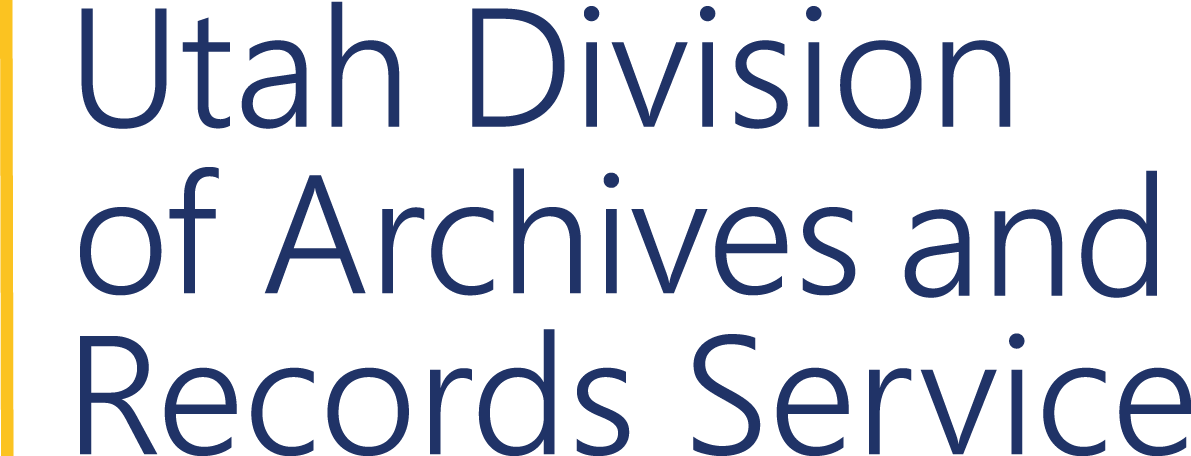Frequently-Asked Questions -- Records and Information Management
- I'm a new records officer. What should I do first?
- How do I take the certification test?
- What is a chief administrative officer (CAO)? What does a CAO do?
- What is an appointed records officer (ARO)? What does an ARO do?
- What is the difference between the Records Center and the Archives?
- What is the process for sending records to the Archives?
- What box must I use to send records to the State Records Center or Archives?
- How do I get records to the Records Center?
- How do I respond to a GRAMA request?
- What is a retention schedule?
- How do I find retention schedules and scheduled record series for my agency?
- Why aren't my records listed on the General Schedule?
- How do I get on the State Archives email mailing list?
- What are approved methods for destroying non-permanent records?
- Does the Archives provide records destruction services?
- Does the State Archives provide any training?
- Can someone from the State Archives come visit my agency and provide training?
- How do I post to the Public Notice Website?
- Will the State Archives digitize my records?
- If I digitize my records, can I throw away the paper?
I'm a new records officer. What should I do first?
- Register and certify as an appointed records officer here.
- Visit and explore the State Archives Website and Open Records Portal. Contact your RIM specialist if you have questions about how to find or use services.
- Assess your agency’s records and recordkeeping systems and become familiar with them. Consult with your former records manager, if possible.
- Attend training sessions offered by the State Archives regarding records access (GRAMA) and records and information management issues.
- Seek the advice of your entity’s chief administrative officer and legal counsel.
- Make sure your duties and responsibilities as a records officer are listed in your performance plan so that you can receive credit for them.
How do I take the certification test?
If you are the official records officer for your agency and are not registered with the State Archives already, register here. your Chief Administrative Officer (CAO) will receive an email asking him/her to approve the appointment; upon CAO approval, you will receive a link to the test. If you have any problems, please contact your RIM specialist. Study materials for the test may be found here.
What is a CAO? What does a CAO do?
A chief administrative officer (CAO) is the senior-level individual responsible for the overall records and information management program for a government agency. Examples of CAO positions include Executive Director, Division Director, County Commissioner, City Manager, and Mayor. The Public Records Management Act (PRMA) details the records-keeping responsibilities of the CAO, which include: establish and maintain an active records and information management program; appoint one or more records officers to work with the state archives; ensure that employees who process records requests are trained; and document the governmental entity’s organization and its functions, decisions, and essential transactions.
What is an appointed records officer (ARO)? What does an ARO do?
A records officer is appointed by the CAO to maintain the agency’s records and serve as the agency’s contact person with the State Archives. Records officers are required to become certified and to work with State Archives in the care, maintenance, scheduling, designation, classification, access, disposal, and preservation of records, as specified by the Government Records Access and Management Act (GRAMA).
What is the difference between the Records Center and the Archives?
The Records Center provides off-site storage free of charge to state and local government agencies, which retain custody of their records while stored at the Records Center. Each record's retention schedule then dictates the final disposition of the records—either destroy or transfer to the State Archives for permanent preservation.
Records held at the State Archives fall under the Archives' custody, and are maintained permanently. Records officers may transfer records with a permanent disposition directly to the State Archives in Salt Lake City, Utah.
What is the process for sending records to the Archives?
After boxes are prepared for transfer according to transfer procedures, submit the Record Transfer Sheet to the Records Center or the State Archives for consideration. A separate form must be submitted for each record series being transferred. List each box and include all descriptions such as the date or file ranges of the records. A member of the Archives staff will contact you about delivery times after the form is received. If you have questions, you may contact a RIM specialist.
What box must I use to send records to the State Records Center or Archives?
Records must be transferred in Records Center boxes, available from Office Depot. These boxes are a proprietary item, meaning their production has been specially contracted in order to meet the specifications required by the State Archives. To order the boxes, follow these steps in order:
- Call 1-888-263-3423.
- Provide your agency's Office Depot Customer Number. If you have no customer number, you will be invited to establish one. You will not be able to order Records Center boxes without it, and the Office Depot representatives must have your account open before they can access the box item number in their computer system.
- Provide the item number for the boxes, which is 285052.
How do I get records to the Records Center?
You can transport records to the Records Center in Clearfield one of three ways:
- Send records via State Mail to Box# 1029
- Mail records to:
- Utah State Records Center
P.O. Box 141029
Salt Lake City, UT 84114-1029 - Deliver records in person by appointment. Arrangements can be made when a Record Center staff member contacts you after receiving the online Records Transfer Sheet. The Records Center is located in Clearfield, Utah. The address is 5th Street & C Street. The buildings there are numbered; the Records Center is C-6. See map.
How do I respond to a GRAMA request?
- Identify the records being requested. if you cannot understand ask the requester for clarification.
- Classify the records being requested; if you need help making a determination consult your attorney or call the government records ombudsman.
- Respond to the request within 10 business days, or 5 business days for an expedited request:
- For public records:
Provide the records to the requester. - For restricted records:
Redact or withhold those records or portions of records and issue a ‘notice of denial.’ - For records your office does not maintain:
Provide a response stating that you do not maintain the records, and if possible provide a referral - For extraordinary circumstances:
If responding to the request involves compiling or summarizing information; if you need to consult with an attorney about classification; or if other extraordinary circumstances apply, respond by notifying the requester and letting him/her know what to expect.
- For public records:
- If you have questions about how to classify records or how to respond, consult the government records ombudsman, who can be reached here.
- Model forms may help facilitate your response. You can find model forms here.
What is a retention schedule?
A retention schedule details the period of time that records must be kept in the custody of their creating agency (including in off-site storage), and whether the records should be destroyed or sent to the State Archives when that retention period has been met.
How do I find retention schedules and scheduled record series for my agency?
Search for your office’s scheduled record series here, or call your RIM specialist for help finding your agency-specific schedules. Or, browse the state, county, city, and school district general schedules.
Why aren't my records listed on the General Schedule?
The general retention schedules establish retention and disposition instructions for records which are commonly created by many governmental entities. When looking for a particular record on the general schedule, be sure to think in broad terms about the information documented, not the types of documents created. For example, rather than looking for a general schedule for meeting agendas, use the open meeting minutes general schedule, which applies to information about the meeting, whether it is documented in an agenda or in the public meeting notice or in another type of document. Please contact your RIM specialist for assistance in using the general schedules, or to create a unique retention schedule for your records.
How do I get on the State Archives email mailing list?
The State Archives does not have an official listserv, but you can subscribe to the Archives blog, where we post information relevant to records and information management, then clicking "Subscribe by Email".
You may also be interested in these other Archives social media outlets:
- Utah State Archives on Facebook, Google+
- Research Center on Facebook, Google+, Wordpress
- Archives Month on Facebook, Twitter
- Highway 89 on Facebook
- Open Records on YouTube
What are approved methods for destroying non-permanent records?
Shredding and burning are both approved methods for destroying non-permanent paper records. It is important that record information be destroyed such that it cannot be pieced back together.
Electronic record information should also be destroyed such that the information cannot be retrieved. Consult with your IT department to determine the best process for your agency.
Does the Archives provide records destruction services?
The State Records Center will only destroy records that are stored at the Records Center at the time that retention is met. The destruction of all other records is the responsibility of the agency that owns the records.
A State Records Center staff member will contact your agency’s records officer when records that are stored at the Records Center are eligible for destruction, and will request permission to destroy the records. Upon agency approval the records will be shredded at a secure facility.
To destroy records that have met retention and are stored at your office, you may contact a reputable shredding company or burn plant. The vendor that the State Records Center uses is Columbus Secure Document Solutions. They can be reached by phone at 801 262-1588 or visit their website.
Does the State Archives provide any training?
The Archives offers training for records managers on a variety of subjects. Training events are offered free of cost. You can see the training schedule and register for classes here.
Can someone from the State Archives come visit my agency and provide training?
Absolutely! Contact your RIM specialist and s/he will be happy to provide one-on-one and in-agency training.
How do I post to the Public Notice Website?
Please visit the Helpful Questions and Answers section of the Public Notice Website for instructions. If you need further assistance, please contact the Public Notice Website administrator, Glen Fairclough, at 801-531-3841 or gfairclough@utah.gov.
Will the State Archives digitize my records?
The State Archives offers reformatting services to convert microfilm or microfiche to digital files, but we do not provide digitization services to convert paper records to digital files. We do offer expertise and suggestions for good scanning equipment, as well as guidelines on meeting digitization standards and planning for the amount of storage space that you will need. For more information, see our Guide to Digital Imaging.
If I digitize my records, can I throw away the paper?
This is a complicated question involving many variables, and should be handled on a case-by-case basis. Please contact your RIM specialist.
Have a question you'd like to ask? Email recordsmanagement@utah.gov and let us know.

Page Last Updated September 19, 2018 .
